Genre: Platformer Developer: TecMagik Publisher: Time Warner Int. Players: 1 Released: 1993
I don’t know how others felt, but I came to find characters like Bugs Bunny, The Roadrunner and Tweety irritating; I actually wanted them to get caught and eaten. I know that what made the cartoons entertaining was that the prey would get the better of the predator, but I just got tired of it. I was even more sympathetic to the nasty Tom, who was really just doing his job when chasing the household pest, Jerry. This made getting to play as Sylvester in Cagey Capers very welcome, since my typical experience playing other games in the genre, is as the heroic underdog and not the villain, driven only by his nature.
This is Cagey Capers: You are Sylvester and you have to catch Tweety. This is really the most refreshing thing about the game. Unlike so many other licensed games, it doesn’t take the simple A to B platformer route and actually tries to play to the source material. In each level or episode, you must chase Tweety through the area, often moving boxes or furniture, jumping on platforms, and avoiding or neutralizing threats from characters more sympathetic to Tweety’s plight. Through doing this, Sylvester is sure to suffer the many indignities and injuries he does in the cartoons such as being electrocuted, smacked by Granny’s mop and mauled by Hector the Bulldog. And at the end of each stage, Tweety will get away again.
While your task in each stage is to catch Tweety, it is never as simple as getting up close and swiping him with your claws. Doing so will only get you a pawful of feathers and a higher score, so it is still worth trying. The gameplay in actuality, comes down to pursuing Tweety from place to place until arrows appear, indicating he can finally be caught. This is more often than not, in the higher part of the level, so a lot of time will be spent ascending platforms. As mentioned, you will also have to move and stack items at times to reach certain platforms. Sometimes you will have to use switches to turn off steam or electricity and you will often be hampered by other characters.
Where the platforming is concerned, Cagey Capers unfortunately makes all the typical mistakes bad platformers do. It is often not clear what is and is not a platform. Sometimes things that really should be, aren’t and things that really shouldn’t be, are. It is also very difficult to tell at times what is part of the background, and what isn’t. Some platforms have to be jumped on precisely in one spot or you will miss and many others are far more lenient. None of this is helped by the learning curve in controlling Sylvester, who seems to be best at short jumps and gigantic horizontal leaps with nothing in between. You can get used to this, but it does take practice and it is not nearly as intuitive as it should be. The characters standing in your way (usually Granny or Hector), appear in certain parts of each stage, and seem to have the ability to teleport, as they will sometimes appear after you just passed then a moment before. There are various ways to avoid them, from throwing bones, hiding in baskets, running away and beating them with a mallet. The behaviour of the characters is inconsistent, sometimes they don’t appear at all and several times during my playthrough, they didn’t even try to attack me. And then other times, they were relentless.
Most of the stages are rather simple once you get used to the gameplay and as long as you remember to chase Tweety from spot to spot, until he is ready to be captured. The most challenging levels come late in the game where Tweety turns into a monstrous bird, the subject of at least one episode I can remember from my childhood. In these two levels, the strategy changes somewhat as there are now antidote bottles that temporarily restore Tweety to his cute self. These, however, are the more confusing and frustrating levels, as the changes are frequent; there aren’t really enough antidotes and Tweety is relentless in his monster form. The only other way I found to transform him was to lose one of Sylvester’s nine lives. The lives are plenty and losing one does not hamper progress, but nine can suddenly seem like very few if you aren’t vigilant.
The sound design and the art style reminded me very much of Taz-Mania with plenty of bleeps and bloops that seem to follow the character’s movements and actions. The actual tunes are more irritating than looney (sorry, I had to). Overall, the game has a definite cartoon feel and this helped mostly by the nice animations and the variety in the level design. Most of the areas are distinct from each other and full of all the things one would associate with the Sylvester & Tweety cartoons.
Cagey Capers has an adjustable difficulty level that strangely works on a percentages rather than the typical easy, normal, hard settings. I am not sure how nuanced it is but setting it to 100% after completion, while making it more difficult didn’t seem to change the game significantly. The length of the game, rather than the difficulty will be the main issue as it contains only seven fairly short levels. It could easily be beaten in less than an hour if you know what you are doing. And while this is true of many games of the time, it probably won’t require too many restarts before you see it to the end.
I do have to give the developers credit for genuinely trying to craft a game around the concept of the cartoon. While the strategy involved in completing levels is an illusion, it still feels different enough to be special. It is short and when difficult, only in a frustrating rather than challenging way, and it has many of the typical design flaws so many platformers of the time did. Despite this, Cagey Capers can still be entertaining while it lasts and is certainly a cautious recommendation to anyone who enjoyed games like Taz-Mania.
SCORE: 5 out of 10

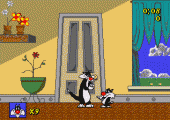
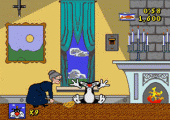
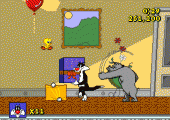
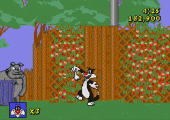
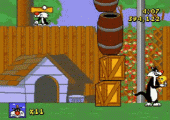

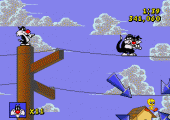
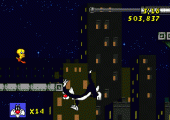

Pingback: Video Game Reviews and Articles | The Essential Malady
Pingback: Video Game Reviews & Articles | The Essential Malady
Pingback: Sega-16 Articles | The Essential Malady